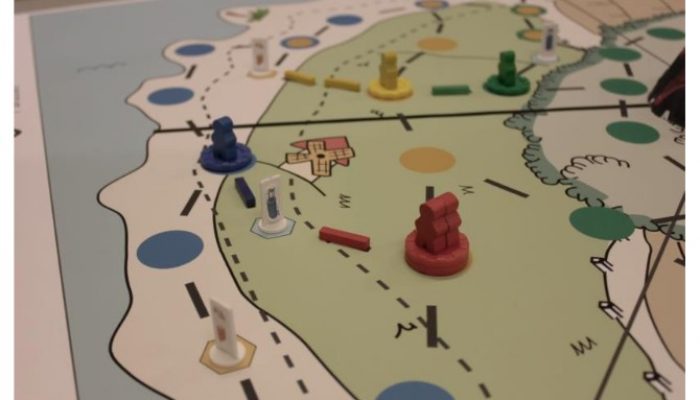
There is no better thing, on a cold and stormy winter’s evening, than to gather your friends for a night of games / board games. Fire blazing (if you have one), tasty snacks laid out and drinks poured, you are all set to indulge in a night of scheming (if you are playing battle ship), deceit (Cluedo), or even all out comedy (think Pictionary or Charades).
The main purpose of the games you are likely to enjoy, in the relaxed setting described above and in the company of your nearest and dearest, is to entertain. You might not be aware that in playing board games you are also boosting your cognitive, decision-making and social skills. Serious games exploit this notion in order to support learning and raise awareness of important issues, as Dr. Mirjam S. Glessmer previously wrote about in our GeoEd column. With this in mind, could a board game be used to raise awareness about the complexities of geohazards and disaster risk reduction management?
A team of Belgian researchers set out to test the idea by developing Hazagora: will you survive the next disaster? Its effectiveness as an educational tool, both for those living in disaster prone areas, as well as stakeholder and scientists involved in risk management activities, is discussed in a paper recently published in the EGU’s open access journal Natural Hazards and Earth System Sciences.
Playing the game
The game is set on an island, with a central volcano surrounded by forests, agricultural lands and coastal areas. Immerse yourself in the game and you’ll have the option to embody one of five characters: the mayor, the fisherman, the lumberjack, the farmer and the tour guide. Potential locations where players can settle, with their families, road networks and wells to provide water supply, are drawn on the board game. The board is divided into different sectors which can be affected by a geohazard. The game is led by a game master, bound to follow the Hazagora guidelines.
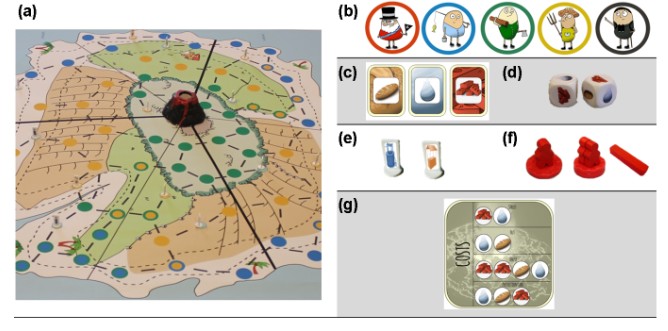
Setup of the game: (a) board game; (b) character cards with from left to right: the mayor, the fisherman, the lumberjack, the farmer and the tour guide; (c) resource cards: bread, water and bricks; (d) resource dice; (e) water well and food market; (f) hut (one chip with one family), house (two chips with two families), and road; (g) cost information card for building new streets, huts, and houses and buying protection cards. Taken from Mossoux, S., et al. (2016).
The outcome of a natural disaster, contrary to common reporting in the media and popular belief, is not exclusively controlled by the force of the natural hazard. The livelihood profile of each of the characters in the game is specifically chosen to highlight the important role economic, social, physical and environmental circumstances play in shaping how individuals and nations are affected by geohazards. A fisherman will inevitably be limited in his choice of settlement location, as he/she is bound to live close to the coast, while at the same time his/her occupation controls its income. On a larger scale, political and socioeconomic factors mean that victims of natural hazards in developing countries, especially Asia and Africa, are more vulnerable to geohazards when compared to residents of developed nations.
Life on the island unfolds in years, with players establishing his/her family on the land by providing shelter, bread (food) and water. Income is received each round table and can be used to a) provide for the family or b) invest in further developing their settlement by adding more housing for extra families. At any given time, and without warning, the game master can introduce a natural hazard (earthquake, tsunami, lava flow, ash fall). All players watch a video clip which illustrates the hazard and outlines the impacts based on recent disasters. The players then discuss the potential damage caused by the hazard to infrastructure, resources and people involved in the game based on factors such as their geographical location relative to the disaster, economic potential and available natural resources. The outcome is displayed on an impact table and the damaged infrastructure removed from the board. Affected families also receive no income during the following roundtable and neighbouring natural resources become contaminated. In this way, the players visually experience complex situations and are able to test new resilience strategies without having to deal with real consequences.
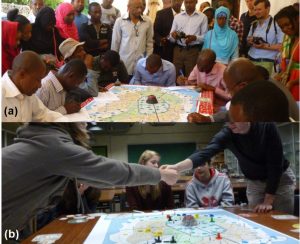
(a) Game session organized with citizens in Moroni (Comoros Islands). (b) Interaction among Belgian students to develop a resilient community. Taken from Mossoux, S., et al. (2016)
Players also have the opportunity to acquire protective action cards which can be used to mitigate, prepare or adapt to hazards. The cards can be used by individuals, but also be part of community actions. During a natural hazard, players can decide to use their cards, individually or as a team, to avoid (some) of the impacts caused by the geohazard. This approach stimulates learning about the risks and mitigation strategies associated with natural hazards, by allowing players to test, experience and discuss new management ideas.
The game lasts for a minimum of five years, or equivalent to three hours game time, after which the resilience of the community (which takes into account factors such as number of living families with permanent shelter and access to natural resources) is evaluated using a resilience index. Players are ranked according to their resilience index, thus generating discussion and analysis of strategies which lead to some players fearing better than others.
Following the game, do players better understand natural hazards?
To test the success of the game at raising awareness of natural hazards, the researcher’s carried out a number of game sessions. A total of 21 secondary school and university students from Belgium, as well as a further 54 students, citizens, earth scientist and risk managers from Africa took part in the sessions. Players completed questionnaires before and after the games to evaluate how their understanding of natural hazards and risk management strategies changed after having played Hazagora.
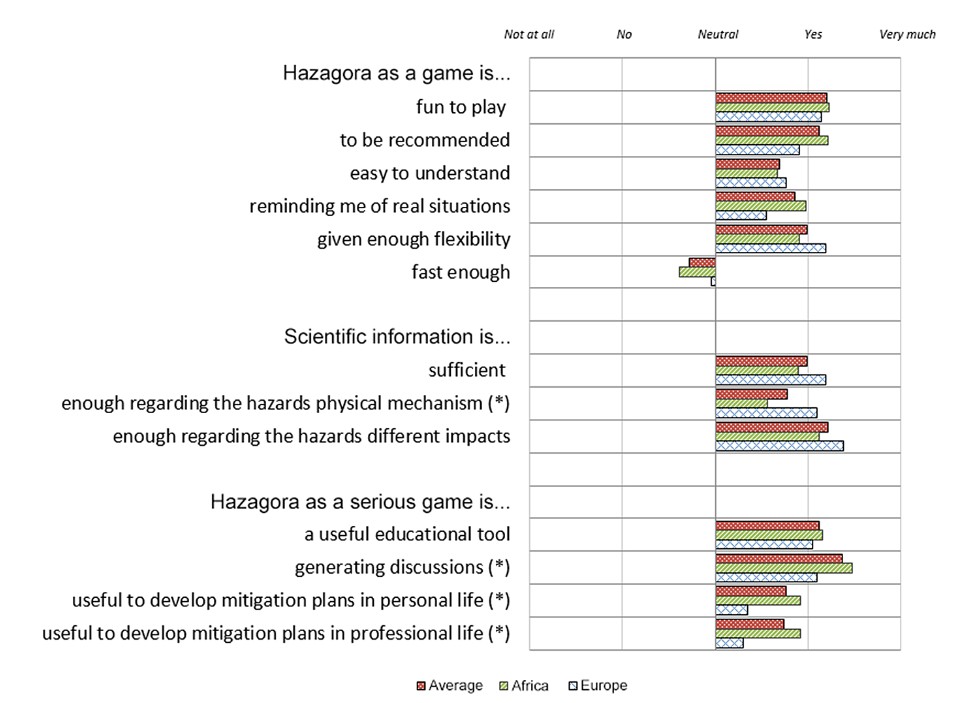
Appreciation of the game by the players (n=75). (∗) Results are significantly different between European and African players (p <0.05). Taken from Mossoux, S., et al. (2016). Click to enlarge.
The questionnaires revealed that participants found the game fun to play and greatly appreciated the flexibility offered to players to come up with their own adaptation and mitigation strategies. The scientific information regarding the physical processes driving natural hazards was the main thing European players learnt from the game. In contrast, West African players highlighted the usefulness of the game to develop personal and professional mitigation plans; the learning outcomes reflecting the differing life experiences and geological situations of the participants.
Hazagora succeeds in making players more aware of the mechanisms which drive natural hazards and how communities’ vulnerabilities differed based on social-economic factors, rather than depending solely on the potency of the geohazard. By driving discussion and collaboration among players it also stimulates engagement with the importance of disaster risk reduction strategies, while at the same time developing player’s social and negotiation skills. And so, following an enjoyable afternoon of gaming, Hazagora achieves its goal and becomes a great addition to the tools already available when it comes to raising awareness of geohazards.
By Laura Roberts Artal, EGU Communications Officer.
References
Mossoux, S., Delcamp, A., Poppe, S., Michellier, C., Canters, F., and Kervyn, M.: Hazagora: will you survive the next disaster? – A serious game to raise awareness about geohazards and disaster risk reduction, Nat. Hazards Earth Syst. Sci., 16, 135-147, doi:10.5194/nhess-16-135-2016, 2016.
Hazagora is a non-commerical game that is available upon request – please contact the study authors for more details.

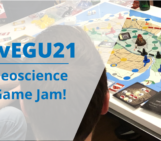

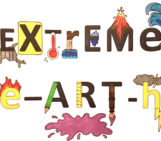
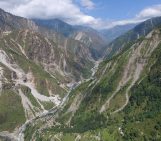
Pingback: GeoLog | GeoEd: A round-up of (geo)educational board games